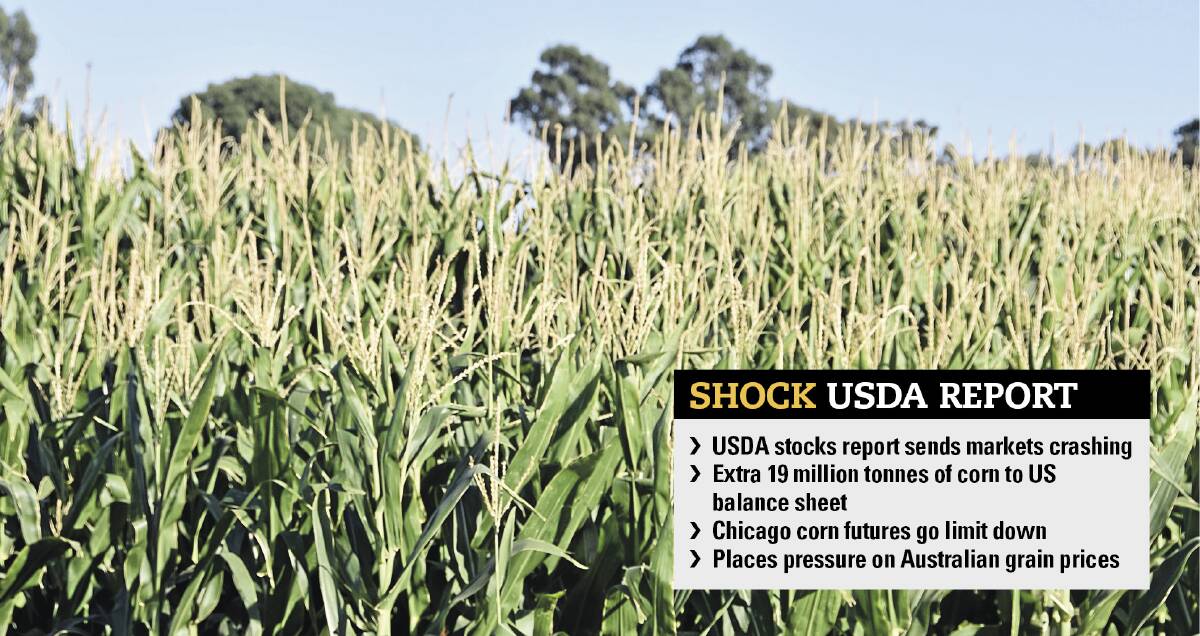
WORLD grain prices took a massive hit overnight on Monday on the back of a US Department of Agriculture (USDA) World Agricultural Supply and Demand Estimates (WASDE) report that failed to make anticipated cuts to US corn acreage and yields.
Subscribe now for unlimited access to all our agricultural news
across the nation
or signup to continue reading
December corn futures with the Chicago-based CME Group slumped the maximum US 25 cents a bushel on the back of the news to close limit down at US392c/bu.
There were further falls early in trade on Tuesday, with the contract dropping to US387c/bu, with some analysts suggesting the fall could go all the way down to US330c/bu.
While not having a direct impact on Australian prices, especially given the ongoing east coast drought meaning domestic markets are again strong, falling North American grain prices will leave the door ajar for grain imports into Australia if local prices rise too high.
Tobin Gorey, Commonwealth Bank commodity analyst, said he did not think this would be the case, but said it was a possibility if there were unexpected issues with the Australian crop.
"The wheat imports we saw were just for specialised use, overall there was enough grain in Western Australia to satisfy demand and I would expect that would be the same again if the season remains on track.
"There is also likely to more grain available in southern states this year so I would not expect there to be a need to bring in grain from overseas," Mr Gorey said.
However, the situation is concerning a Riverina farmer, who has said he has concerns about the potential for grain imports to become the norm for Australia.
"I'm worried that the Manildra wheat imports earlier this year may just be the thin edge of the wedge," Bob McCormack, who farms near Junee.
"You can see the occasion where the world market is held over Australian producers, if the end users are not happy with the price they see here they will just look to import wheat, solely based on price," Mr McCormack said.
At present imported wheat can only head to non-grain producing regions and the stock feed sector has said it cannot comply with biosecurity requirements in an economic fashion, however Mr McCormack cautioned not to rule it out.
"It's something, as an Australian grain grower, I am very concerned about, I don't want to see grain imports coming in when they are not strictly necessary."
Rough calculations have it that it costs around $100/t to bring in grain from overseas, as well as adhering to the strict biosecurity requirements, which has meant most grain users have publically said they would only consider imports as a last resort.
Internationally, the sharp fall, which saw the CME market go limit down in a matter of minutes, was the biggest drop in corn values since 2013.
Mr Gorey said the USDA did reduce corn acreages, but not by as much as expected.
Combined with a yield estimate significantly higher than what the trade was expecting, it meant the USDA was predicting an extra 19 million tonnes of corn on the balance sheet.
"Getting rid of that extra corn takes a lot more chewing, distilling and shipping than the market was expecting," Mr Gorey said.
He said there was scepticism in the market over whether the USDA yields were overly optimistic.
"At present the market is torn between rejecting the USDA's yield estimates or admitting it was wrong."
Mr Gorey said he expected further falls in the global corn market, correcting the rises seen during the soggy planting period in May / June when there was concern about Midwest farmers' ability to plant.


